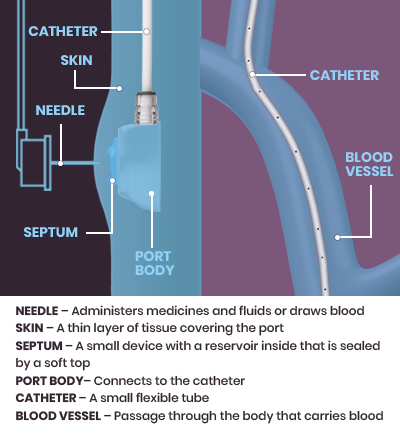What Is A Port?
A port is a small device with a reservoir inside that is sealed by a soft top called a septum. The port connects to a small flexible tube called a catheter, which is inserted into a vein. A special needle punctures the septum of the port so that medicines and fluids can be given and blood samples withdrawn. There are many different kinds of ports. Your healthcare provider will select the port that is best for you.

Where is a Port placed?
The port is typically placed under the skin on your chest or arm. The port connects to a small, soft tube called a catheter. The catheter is placed inside one of the large central veins that take blood to your heart. The port creates “access” to your bloodstream. Medicine and fluids can be given through the needle and blood samples can be withdrawn. Ask your healthcare provider about the ideal placement location that is best suited for your treatment.
Why might you consider a Port?
Your treatment may require frequent delivery of medicine or fluids into your bloodstream. Your healthcare team may also require blood samples. If this is the case, a port may be an appropriate option for your treatment.
Comfort
Your healthcare team can give medicines or fluids through your port. They may also take blood samples. They will not need to stick the veins in your arms with a needle. This makes it more comfortable for you. Medicines are less irritating because the port delivers medicines into a large central vein.
Long-term Health
Catheters placed in larger, central veins avoid damage to veins in the arm or hand that can be caused by certain medications.
Lifestyle
Implanted ports, compared to other centrally placed vascular access devices, are more likely to permit you to go about your normal day-to-day activities, like showering and swimming. Ask your healthcare team about specific activities and the appropriate time to resume them.
Increased privacy and appearance
With an implanted port, there is no exposed device. Implanted ports are small and can be hidden from view. No one needs to know about your treatment unless you want them to.
Did you know?
If you are receiving an infusion treatment, it may involve frequent injections or infusions of medication and other fluids directly into the bloodstream. The treatment may also require that blood samples be withdrawn. An implanted port may help to decrease the discomfort of these procedures. Ask your healthcare provider if a port is right for you.
1 Nagel SN, Teichgräber UK, Kausche S, Lehmann A. Satisfaction and quality of life: a survey-based assessment in patients with a totally implantable venous port system. Eur J Cancer Care (Engl). 2012;21(2):197-204. doi:10.1111/j.1365-2354.2011.01275.x
